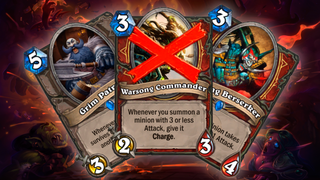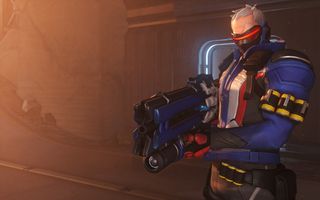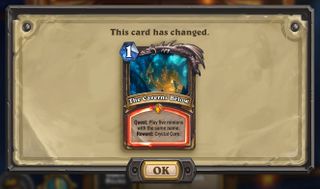'There are no one percent changes.' Ben Brode on how Hearthstone balance differs from Overwatch
The Overwatch team approaches balance using the points on a so-called balance triangle. Does the same philosophy work for Hearthstone?

Is Hearthstone balance a triangle? This question has nagged me ever since Overwatch director Jeff Kaplan explained that the Overwatch team approaches balance using the points on a so-called balance triangle: their gut feeling, statistics like hero pick rates, and player feedback about the game. Which got me thinking, does Hearthstone have three points as well?
The broader question is: how is Hearthstone balanced? Which feels strange to ask. Hearthstone is much older and I'm far more familiar with the scene, yet I feel like I know more about the way Overwatch does balance. Maybe that's because the Overwatch team regularly offers granular analyses of balance changes, whereas the Hearthstone team can be less precise and transparent. Maybe it comes down to quantity. Overwatch has seen a staggering 119 updates in the year since it launched, but Hearthstone's changes are comparatively few and far between.
For the past three months, the Hearthstone ladder meta was warped by Quest Rogue, a powerful—and very popular—combo deck built around the Rogue Quest card The Caverns Below. Completing the deck's Quest let you flood the board with 1-mana 5/5s, often as early as turn four, outpacing aggro decks and absolutely punishing slower, skill-heavy control decks. We've seen powerful and over-popular decks before—and undoubtedly will again—but Quest Rogue was a very special kind of bust.
"Quest Rogue is a deck we cannot have in competitive Hearthstone," says Peter 'Gaara' Stevanovic, winner of DreamHack Bucharest 2014 and one of Tempo Storm's Hearthstone pros. "Not just because it has super polarized matchups, but because it targets the decks that require the most skill. Quest Rogue naturally counters every slow deck, and that is completely unacceptable."
Following considerable outcry from players, Quest Rogue was finally nerfed a few weeks ago. The patch notes echo Gaara's argument, describing how the chilling effect on control decks was unhealthy. But why was it so much worse than previous 'non-interactive' decks? For starters, Gaara says, you always draw the quest—the key card—making the deck more consistent. David 'JustSaiyan' Shan, another Tempo Storm player, points out that Quest Rogue can also complete its quest as early as turn three and end games far sooner than previously nerfed decks like Patron Warrior and Combo Druid did.
Quest Rogue is a deck we cannot have in competitive Hearthstone.
Peter 'Gaara' Stevanovic
Every player I spoke to agreed the deck had to be changed, and many felt the nerf could have come sooner. More importantly, most would prefer more frequent balance changes in general.
"I think constant balance changes could hurt new or more casual players because it would be more difficult for them to keep up with the changes," says Johnnie 'Ratsmah' Lee, a Tempo Storm player who specializes in the game's Arena format. "However, I personally would love to see balance changes as frequently as possible because of the static nature of the game." Victor 'VLPS' Lopez felt the same and says balance changes have been more frequent, but not frequent enough.
Comic deals, prizes and latest news
Sign up to get the best content of the week, and great gaming deals, as picked by the editors.
The limitations of updates
Quest Rogue was certifiably busted, but that still leaves the question of why Hearthstone's balance updates come in a trickle compared to Overwatch's torrent. Why was Quest Rogue left untouched for so long, and why are balance changes so scarce? To answer these and other questions, I spoke to Hearthstone game director Ben Brode.

"There are no one percent changes we make to cards; they're dramatic."
"Right now, the reality that we're living in is: if we want to make a nerf, it has to be with the planned patches that we've already got going on," Brode says. "The way we've currently built things, we often release an expansion and then we patch maybe once every month or two. Those are our opportunities right now to make balance changes, because the cards are included with the client.
Brode's answer sheds some light on Team 5’s reputation of being hesitant to nerf cards. It may well be that they're as eager to nerf something as players are, they just can't push the update through immediately. It helps that designers like Brode are making more and more of an effort to communicate and interact with players in public forums like Reddit and Twitter. And it sounds like the rate of change may speed up in future.
"We're making big changes to the underlying structure of the game right now," Brode says, "which will eventually allow us to stream card changes down directly if we want to make a balance change outside of our normal patch cycle. There have been times, and Small-Time Buccaneer is a good example, where we've decided on a nerf and we're just a few weeks away from our next patch. So, often we end up in a space where we're like 'we're going to patch soon, we've got to make a decision now about whether to do the nerf or wait a month before we consider it again.' We're trying to move away from that and be a little more agile about nerfs in the future."
There's also another big reason for Blizzard's reputation for slow updates: they are hesitant to nerf cards.

"I think there's costs to nerfing, and there's types of nerfs that are more costly," Brode says. "For example, the way in which we nerfed Warsong Commander has a long-term cost to seeing that card. And we hear stories about players who come back to Hearthstone after two years, and they pick up their [Patron Warrior] deck that they loved, and the deck doesn't work anymore, at all. It's not at a lower power level, it's broken. We broke it, sorry. That's not a great experience there, either."
There's a precious sense of ownership in Hearthstone. It's gratifying to save up dust, craft a new deck and learn to play it, and it sucks to get your new toy taken away, even with the dust refund offered when cards are nerfed. Blizzard has to account for that—and not only that, Brode says, but also how noticeable nerfs are in Hearthstone, which highlights a key difference from Overwatch.
"There's a difference between a game where the numbers are obfuscated from you," he says. "If it's a first-person shooter and I shoot a gun, whether I dealt 794 damage or 795 damage is imperceptible to me, but it might make the one percent difference in balance to get classes closer together. Hearthstone doesn't have that luxury. With Small-Time Buccaneer, we changed one number by one and we halved it. There are no one percent changes we make to cards; they're dramatic."

In November of last year, the Overwatch hero Soldier: 76's damage per bullet was increased from 17 to 20, a change that propelled him from seldomly-used to one of the most-picked DPS heroes in the game. Then, in May of this year, his damage was adjusted again from 20 to 19 damage per bullet. "Soldier: 76 is in a much better place lately, but his damage output was making him a must pick, compared to similar roles," read the patch notes at the time.
Incremental balance changes like this are a luxury that Hearthstone doesn't have. "When we make a nerf, just by the nature of—we call them crunchy numbers—we have to double, halve, those kinds of changes," Brode says. "They're very disruptive in a way that isn't as elegant as the kinds of changes you could make in small, incremental balances in other types of genres. So there's more hesitance to do a nerf when it's not necessary."
I shudder to think of a world where all Overwatch balance updates are as drastic as the recent nerf to Roadhog's scrap gun, which severely reduced his ability to one-shot heroes after pulling them in with his hook. But even that doesn't hold a candle to the impact of the Warsong Commander nerf. The equivalent would be replacing Roadhog's ammunition with cotton balls.
To nerf, or not to nerf
Now, about that triangle. What combination of data points and instinct lead to nerfs in Hearthstone? (Because, let’s be honest, it’s never buffs, for reasons Brode has discussed.) Is it really as simple as hammering the nail that sticks out? Not so, it seems. For example, Combo Druid was nerfed to free up design space for Druid in Standard, Brode says, whereas Patron Warrior was nerfed because it was terrorizing the competitive scene. In fact, win rate alone is virtually never behind nerfs. Quest Rogue was also a special case, and an outlier even among problem decks.
"We're in this world where Quest Rogue is posting kind of middling numbers, maybe our 17th best deck, but it was 10 percent of the meta," Brode says. "That doesn't add up. Why would our 17th best deck be in our top three play rate decks? Those are just nonsensical numbers. We were hoping to see that change, because usually things trend in that direction. It didn't change as fast as we wanted it to, so we stepped in and made a change."
Patron Warrior is the deck often cited as having the most detrimental effect on competitive Hearthstone, but as prolific as it was, Brode thinks Quest Rogue was worse. This time Team 5 was quicker to respond.
Brode says Quest Rogue was on the team's radar as a potential imbalance before Journey to Un'Goro even released.
"I think Quest Rogue was having a bigger impact on the meta for the average Hearthstone player's experience of going in, playing and getting beaten by Quest Rogue a lot," he says. "It had a higher win rate and a higher play rate than Patron Warrior. I think that's part of why the nerf happened sooner."
Brode says Quest Rogue was on the team's radar as a potential imbalance before Journey to Un'Goro even released. They held off on nerfing it not only because they weren't yet positive it was a problem, but because they didn't want to deny players the opportunity to answer it themselves.
"You want a system where players are in control," Brode says. "Where they see a meta and they're like, 'this is what people are playing. I am going to play this deck because I think it's very good against the decks that other people are playing.' And you've made a correct guess, so your deck is now winning more than any other deck because you are countering the meta… That's what we'd like to see, players changing their decks and coming up with new strategies to counter the decks they're seeing."
In this sense, an abundance of nerfs could actually worsen the experience by making players less motivated to experiment and find solutions themselves. Interestingly, Brode's stance lines up with a recent forum post from Overwatch's Jeff Kaplan.
"I do not agree with the philosophy that we should just make balance changes solely to shift people off the meta … balancing heroes who are unbalanced is good, balancing heroes just to make them picked more or picked less is not good (in my humble opinion)," he wrote, adding that seeing the meta change because players come up with new strategies "is the best-case scenario."
Stats on stats
What about the influence of community feedback? Which is more important: stats like win rates and pick rates, or how players say it feels to play with or against something? Historically, Overwatch has done a good job of representing the two equally. Symmetra was overhauled because she was boring to play, for instance; stats weren't necessarily the biggest factor behind the change. Kaplan revisited this idea in his forum post.
"Statistically, the things that are most unbalanced aren't what you think they are," he wrote. "Symmetra and Torbjörn win rates are not balanced. They are too good. But this is why we don't balance on statistics alone."
Contrastingly, Hearthstone is often perceived to be governed largely by statistics. Several of the pro players I spoke to felt that player sentiment was outweighed by win rates, in no small part because Blizzard has leaned on those numbers in the past when justifying balance changes or an absence thereof. But Brode says the player experience is always critical to their balance process.

"We take the community sentiment and it goes in with the stats," he says. "The ideal for us is when the meta corrects and adjusts over time to mix up the top. If we see that player sentiment is negative on a strategy or a card but the statistics are pointing us in a direction where that might change, that might make us more hesitant to nerf."
Things are different when players don't have a good option available to develop a counter to a dominant strategy and shift the meta. "When the player sentiment is negative then—when we can see that there's not something else going on that might shake things up—that's when we're really like 'it's time to make a change.'"
That's exactly what happened with Quest Rogue. Not only was it inordinately harmful to control decks and frustrating to lose to, it lacked readily accessible counters beyond ultra aggro. It felt like Jade Druid on a bender; control decks couldn't handle an army of 1-mana 5/5s coming out as early as turn four. This is partly why Blizzard nerfed it the way that they did, according to lead final designer Mike Donais.
We talked about a bunch of different options for Quest Rogue. Making the minions 4/4 was one, increasing the cost of the quest reward to eight was another.
Mike Donais
"We talked about a bunch of different options for Quest Rogue," Donais tells me. "Making the minions 4/4 was one, increasing the cost of the quest reward to eight was another option we discussed. In the end, we went with the change of needing to play five minions of the same name for a few reasons. One was that it felt the most similar to the old version of the quest when played and played against. Another was the numbers all line up cleanly, making them easy to remember and process."
"Honestly, every situation's been different," Brode says. "And we're still kind of figuring things out, right? Every situation has been kind of unique. It's been interesting to have these conversations to figure out when's the right time to make changes and when not to."
Not quite a triangle then, but the similarities between Overwatch and Hearthstone's balance processes and philosophies are striking. There are also significant gaps between the two games, which represent opportunities for each to learn lessons from the other. Both are ongoing battles in which the work will never be truly finished, and the next controversy is only ever a flappy bird or unkillable Bastion away.

Austin freelanced for PC Gamer, Eurogamer, IGN, Sports Illustrated, and more while finishing his journalism degree, and has been a full-time writer at PC Gamer's sister publication GamesRadar+ since 2019. They've yet to realize that his position as a staff writer is just a cover-up for his career-spanning Destiny column, and he's kept the ruse going with a focus on news, the occasional feature, and as much Genshin Impact as he can get away with.
Most Popular



